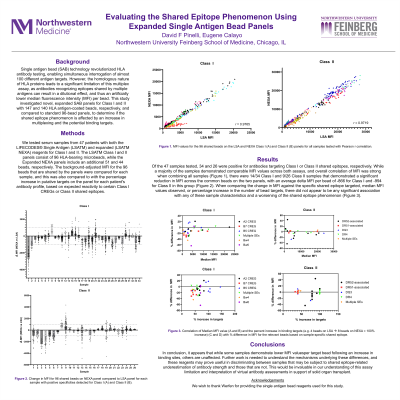Back

Evaluating the Shared Epitope Phenomenon Using Expanded Single Antigen Bead Panels
(P706) Evaluating the shared epitope phenomenon using expanded single antigen bead panels
Location: Platinum Ballroom


David Pinelli, PhD, F(ACHI)
Northwestern University
Poster Presenter(s)
Aim: Single antigen bead (SAB) technology revolutionized HLA antibody detection, enabling simultaneous testing against almost 100 different antigen targets. However, the homologous nature of HLA proteins leads to a significant limitation of these multiplex assays, as antibodies recognizing epitopes shared by multiple antigens can result in a dilutional effect, and thus an artificially lower median fluorescence intensity (MFI) per bead. This study investigated novel SAB panels for Class I + II with 147 and 140 HLA antigen-coated beads, respectively, to determine if the shared epitope dilution effect is magnified by an increase in potential antibody binding targets.
Method: We tested serum samples from 47 patients with the LIFECODES® Single Antigen (LSATM) and expanded (LSATM NEXA) reagents for Class I and II. The change in background-adjusted MFI for the 96 beads that are shared by the panels were calculated for each sample and also compared against the percent increase in putative targets on the panel for each patient's antibody profile.
Results: Of the 47 samples tested, 34 and 26 were positive for antibodies targeting Class I or Class II shared epitopes, respectively. While a majority of the samples demonstrated comparable MFI values across both assays, there were 14/34 Class I and 9/26 Class II samples that demonstrated a significant reduction in MFI across the common beads on the two panels, with an average delta MFI per bead of -866 for Class I and -994 for Class II in this subgroup. Across the entire study, when comparing the change in MFI against the specific shared epitope targeted, range of MFI values observed, or percent increase in targets, there did not appear to be any significant correlations.
Conclusion: In Conclusion, it appears that certain samples are susceptible to worsening of the shared epitope phenomenon with an increase in binding targets, while others are unaffected, resulting in similar MFI values despite the expansion of the panel. Further work is needed to understand the mechanisms underlying these differences. Interestingly, these reagents may prove useful in discriminating between samples that suffer from shared epitope-related MFI dilution and those that do not. This would be invaluable in our understanding of this assay limitation and interpretation of virtual antibody assessments in support of solid organ transplant.
Method: We tested serum samples from 47 patients with the LIFECODES® Single Antigen (LSATM) and expanded (LSATM NEXA) reagents for Class I and II. The change in background-adjusted MFI for the 96 beads that are shared by the panels were calculated for each sample and also compared against the percent increase in putative targets on the panel for each patient's antibody profile.
Results: Of the 47 samples tested, 34 and 26 were positive for antibodies targeting Class I or Class II shared epitopes, respectively. While a majority of the samples demonstrated comparable MFI values across both assays, there were 14/34 Class I and 9/26 Class II samples that demonstrated a significant reduction in MFI across the common beads on the two panels, with an average delta MFI per bead of -866 for Class I and -994 for Class II in this subgroup. Across the entire study, when comparing the change in MFI against the specific shared epitope targeted, range of MFI values observed, or percent increase in targets, there did not appear to be any significant correlations.
Conclusion: In Conclusion, it appears that certain samples are susceptible to worsening of the shared epitope phenomenon with an increase in binding targets, while others are unaffected, resulting in similar MFI values despite the expansion of the panel. Further work is needed to understand the mechanisms underlying these differences. Interestingly, these reagents may prove useful in discriminating between samples that suffer from shared epitope-related MFI dilution and those that do not. This would be invaluable in our understanding of this assay limitation and interpretation of virtual antibody assessments in support of solid organ transplant.
